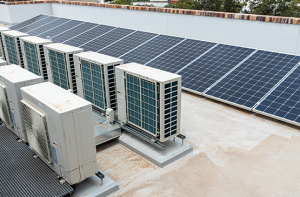Community Solar: No Capital Required for Green Electrons
By any measure, the shift to clean energy has been remarkable. The rapid expansion of energy generated by wind and solar means that 20% of the U.S. electric grid is now powered by renewables, with some electric grid segments approaching 40%.
As the shift to decarbonize electricity accelerates, more alternatives in accessing “green electrons” are growing, as well. For rental residents, this is particularly important.
Multifamily housing presents several challenges for on-site renewable generation. Apartments, townhomes and condos often do not have the right or enough roof space to install their own solar. Other roadblocks — capital investment, dealing with complexities of permits, growing interconnection queues, supply chain challenges and disruptions ― make on-site solar a lot to navigate.
For those seeking to lower their greenhouse gas emissions and negative impacts on our climate (and save some money while you’re at it), there is an alternative: community solar.
What is community solar?
Community solar is a solar project or purchasing program, within a geographic area, in which the benefits of a solar project flow to multiple customers, such as individuals, businesses, nonprofits, and other groups. There are typically two community solar purchasing models: indirect and direct.
Often referred to as “solar farms,” indirect community solar is most frequently an off-site photovoltaic (PV) array. Residents lease the energy generated by the farm’s solar panels. Signup is voluntary but not available everywhere, either restricted by local government regulation or by supply too limited to meet the demand.
Direct community solar indicates direct investment, as well as potential on-site generation. These community solar installations can be larger PV arrays financed by a local group, such as an HOA. The issue of who takes on the capital investment to build and maintain the solar project is spread across a group of investors that directly use the green electrons.
Community solar helps reduce GHG emissions
GRESB is a recognized global leader in delivering, scoring, validating and reporting commercial real estate data to the capital markets. According to GRESB, residents who sign up for community solar help their properties lower their Scope 3 emissions, which is increasingly important to reach ESG goals. If a property installs solar onsite, they lower their indirect emissions from the grid, characterized as Scope 2.
Residents save money on their electric bills
“Renters often look to community solar to lower their carbon footprint but are often surprised these agreements save them money too,” says Dimitris Kapsis, VP Energy and Sustainability Services at RealPage. The most effective community solar offerings for multifamily provide a mobile app for residents, said Kapsis. The app engages residents by illustrating savings as well as the billing provided by the electric utility.
Kapsis adds that savings vary based on seasons, equipment on a property, and location. If a property uses gas for water and space heating in winter, savings will seem low during cold seasons. During the summer, however, when air conditioning and other cooling are used, savings will be greater.
Fast: No permitting, interconnection, supply chain or other buildout woes
The COVID-era supply chain woes have impacted equipment for solar installations, a situation being remedied with more solar plants opening in North America. Interconnection, the process of connecting a solar power installation to the electric grid, has increased queues based on more solar, wind, electric vehicle chargers and energy storage (batteries for buildings).
Easy: Benefits of solar at the click of a signup form
When and where available, signing up for community solar is typically as easy as choosing a rate structure with a local utility. The trick is living in or owning/operating rental real estate within a jurisdiction favorable to community solar. For example, Colorado currently has one of the most favorable U.S. markets for both access and pricing of community solar electricity. Other favorable locations include the Washington, D.C. metro area and Maine.
Community-driven savings starts now One more thing to know about solar: These opportunities are very popular and get subscribed to quickly. Sign up now to start cutting emissions and saving money sooner.
Historical perspective
- March 2024
- February 2023
- July 2022
- March 2022
- June 2021
- February 2021
- August 2020
- February 2020
- July 2019
- April 2019
- June 2018
- April 2018
- October 2017
- May 2017
- November 2016
- June 2016
- November 2015
- June 2015
- September 2014
- June 2014
- April 2014
- December 2013
- July 2013
- December 2012
- July 2012
- October 2011



